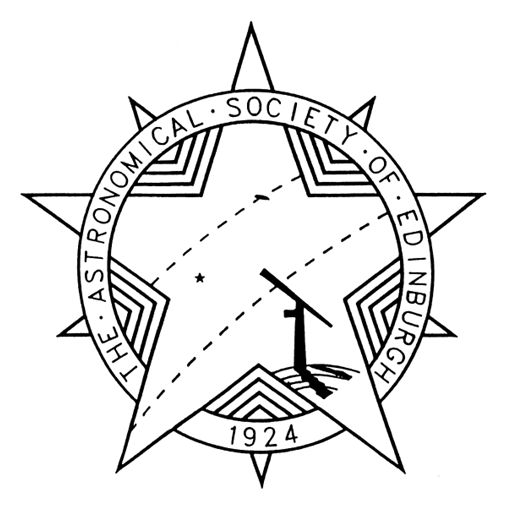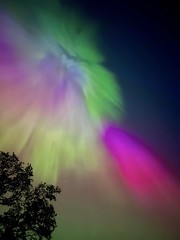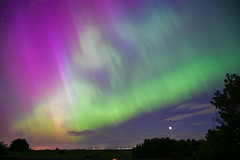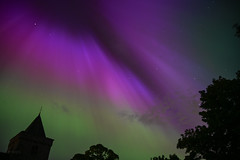Monthly Archives: April 2018
Scotland’s Sky in May, 2018
Posted by ASE
Jupiter’s conspicuous opposition in the Balance

The maps show the sky at 01:00 BST on the 1st, midnight on the 16th and 23:00 on the 31st. Arrows depict the motions of Jupiter during May and of Venus from the 20th. (Click on map to enlarge)
Jupiter is at its brightest and best in the constellation of Libra, the Weighing Scales or Balance, this month. Its opposition, when it stands directly opposite the Sun, occurs on the morning of the 9th but it is prominent every night as it transits low across the south from the south-east at nightfall to the south-west before dawn.
Venus, however, outshines it in the western evening sky and both Saturn and the increasingly striking Mars follow Jupiter into the southern morning sky.
The Sun climbs another 7° northwards during May as Edinburgh’s sunrise/sunset times change from 05:29/20:52 BST on the 1st to 04:36/21:45 on the 31st. Because twilight is also lengthening, official darkness in the middle of the night lasts for under one hour by May’s end.
The Moon is at last quarter on the 8th, new on the 15th, at first quarter on the 22nd and full on the 29th.
Venus stands 20° high in the west at sunset, sinking to set in the north-west by 23:40 on the 1st and one hour later by the 31st. Brilliant at magnitude -3.9, it begins the month 6° above-right of Taurus’ brightest star, Aldebaran, and tracks east-north-eastwards between the Bull’s horns to end May in mid-Gemini, below Castor and Pollux.
The young earthlit Moon makes an impressive sight almost 6° below-left of the planet on the evening of the 17th. Three days later, as Venus joins the region of sky covered by our chart, it passes 1.0° (two Moon-diameters) above-right of the star cluster M35 whose brightest stars may be glimpsed through binoculars from their distance of some 2,800 light years. Still on the far side of its orbit, Venus approaches from 217 million to 190 million km this month as its almost-full disk swells to 13 arcseconds in diameter.
After dominating our winter nights, Orion ducks below our western horizon as the evening twilight fades at present. The Plough is overhead and Leo high in the south with its main star Regulus which has a close encounter with the first quarter Moon on the night of 21st/22nd.
By our map times, Leo sis inking in the west and Jupiter is easily the most conspicuous object in the south though it stands barely 18° high for Edinburgh. Moving westwards in Libra, it lies close to the Moon on the 27th. Its motion takes it from 4° east (left) of the well-known double star Zubenelgenubi at present to lie just 1.0° north-east of the star on the 31st.
Jupiter is 658 million km away at opposition, shines at magnitude -2.5 and shows a 45 arcseconds wide disk through a telescope. Its two main darker cloud bands, its northern and southern equatorial belts, straddle a lighter equatorial zone. The famous Great Red Spot is gradually losing its status, however, being less than half as wide as it was a century ago and currently more salmon-pink in hue than red. It sits in a bay at the southern edge of the south equatorial belt and, like the many other Jovian cloud features, is carried smartly across the disk as the planet spins in just under ten hours.
Steadily-held binoculars show the four main moons of Jupiter, Io, Europa, Ganymede and Callisto which change their configuration to the east and west of Jupiter from night to night, sometimes disappearing as they hide behind Jupiter or cross the disk, along with their shadows.
If Jupiter’s low elevation makes telescopic views less than sharp, this is even more the case with Saturn which rises in the south-east at our map times and is 6° lower in the sky than Jupiter as it reaches the meridian just before dawn. Saturn improves from magnitude 0.4 to 0.2 as it creeps westwards above the Teapot asterism in Sagittarius. It lies 1,392 million km away at mid-month when its oblate globe is 18 arcseconds across set within 40 by 17 arcseconds rings that have their north face inclined at 26° to our view. Look for it 4° right of the Moon on the morning of the 5th.
Less than 2° below Saturn is the globular star cluster M22, a ball of thousands of stars that lies about 10,600 light years away and formed some 12 billion years ago. At about magnitude 5.1 and visible as a hazy glow through binoculars, it was the first globular to be discovered and is brighter than M13 in Hercules, the best globular in the northern sky.
Mars lies almost 15° east of Saturn at present and rises at Edinburgh’s south-eastern horizon at 02:46 on the 1st. As it more than doubles in brightness, from magnitude -0.4 to -1.2, it also speeds 12° eastwards from Sagittarius to Capricornus so that by the 31st it rises at 01:31 and its fiery glow is unmistakable above the south-south-eastern horizon before dawn.
Catch Mars below the Moon on the morning of the 6th. Telescopically, its disk swells from 11 to 15 arcseconds as its distance falls from 126 million to 92 million km. Its approach opens the optimum window for sending probes to the planet and NASA’s InSight lander to study “marsquakes” and the Martian interior is due for launch between 5 May and 8 June.
Meteors of the Eta-Aquarids shower, debris from Comet Halley, appear until the 20th as they radiate from a point that lies low in the east for an hour or so before dawn over Scotland. The shower peaks with some moonlight interference on the 6th and brings a fine shower for watchers further south but only a handful of meteors for us.
Diary for 2018 May
Times are BST
3rd 18h Venus 7° N of Aldebaran
4th 21h Moon 1.7° N of Saturn
5th – 6th Peak of Eta Aquarids meteor shower
6th 08h Moon 2.7° N of Mars
8th 03h Last quarter
9th 02h Jupiter at opposition at distance of 658 million km
15th 13h New moon
17th 19h Moon 5° S of Venus
22nd 03h Moon 1.5° N of Regulus
22nd 05h First quarter
27th 19h Moon 4° N of Jupiter
29th 15h Full moon
Alan Pickup
This is a slightly revised version, with added diary, of Alan’s article published in The Scotsman on April 30th 2018, with thanks to the newspaper for permission to republish here.
Posted in Uncategorized
Tags: Alan Pickup, Aldebaran, ASE, Astronomical Society of Edinburgh, Capricornus, Comet Halley, diary, Eta-Aquarids, Gemini, Great Red Spot, Hercules, Jupiter, Leo, Libra, M13, M22, M35, Mars, marsquakes, Mercury, meteor shower, NASA InSight, Night Sky, Plough, Sagittarius, Saturn, Scotland, Taurus, The Scotsman, Venus, Zubenelgenubi



